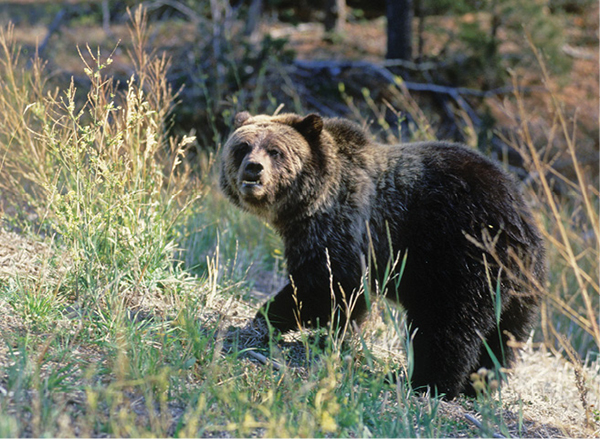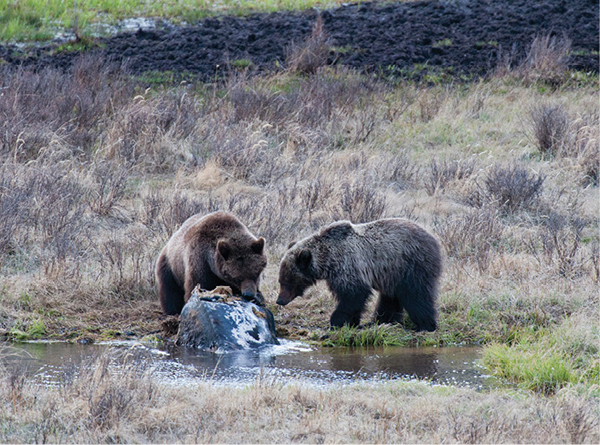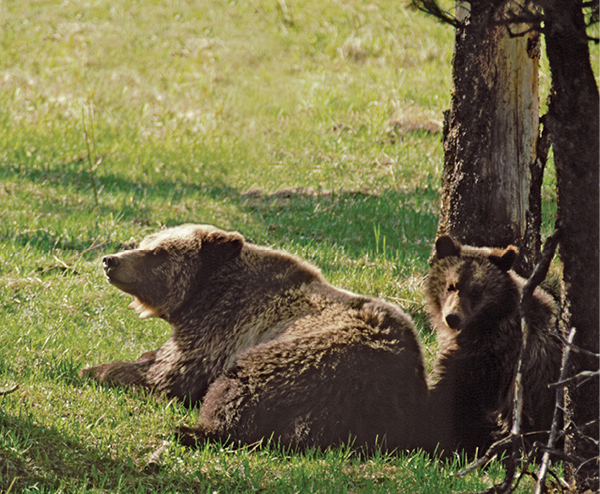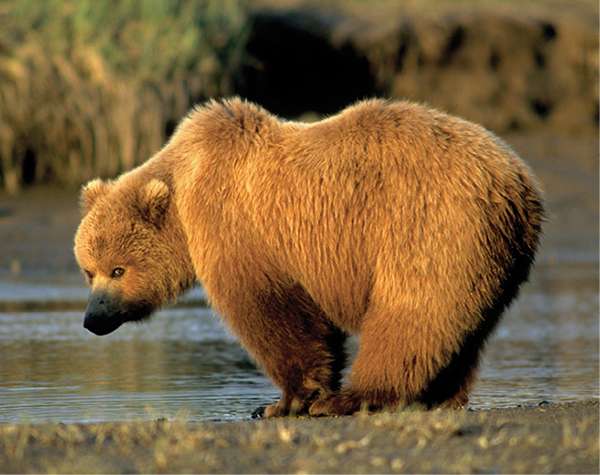
Hunters surprising grizzly bears in cover at close range is a common cause of grizzly attacks on humans.
Humans and Bears: Current Interactions and Precautions
The thought of being attacked by a grizzly bear is enough to keep some people from recreating in bear habitat or may leave them shivering in their sleeping bag or constantly looking over their shoulders for a ghost bear when hiking. However, statistics reveal that this fear, while potentially a strong motivator for taking precautions that protect both bears and people, is unfounded. As many outdoor folks are fond of quipping, you’re probably at greater danger from dying in an automobile accident on the way to the trailhead than encountering the jaws of an enraged grizzly while on the trail. Dogs and lightning strikes both kill more people per year, on average, than grizzly bears. Nonetheless, grizzly bears do occasionally attack and kill people. In some years several deaths have occurred in the contiguous United States in a single season of grizzly activity, from the time of their emergence from their dens in the spring until they hibernate in the winter.
Certain scenarios greatly increase the odds of a grizzly attacking a human. Hunters are often at much higher risk than hikers or other backcountry users. The tactics used by human hunters to control their scent, walk quietly to avoid detection by their quarry, and hide from sight up the odds of surprising a grizzly bear at close range. In some areas grizzly bears seem to have associated rifle shots and human activity in the fall with food in the form of discarded entrails and carcasses. A hunter returning to a kill site to retrieve meat from an animal may come upon a grizzly bear that has claimed the carcass and aggressively defends it. While human hunters encounter risk from inadvertently provoking a grizzly bear, bears are also at risk from hunters. In many places legal black bear hunting takes place in grizzly habitat. Grizzly bears being misidentified and downed by black bear hunters is a common occurrence.
The same behavior (defending a carcass) that may provoke conflict between hunters and grizzly bears also puts other recreationists at risk. Hikers or backcountry anglers may accidentally stray close to a carcass being eaten by a grizzly bear, triggering an aggressive response. When in grizzly bear habitat, if you see or smell carrion, it’s wise to back out of the area the way you came and either give the location a wide berth or take your recreation elsewhere.

Hunters surprising grizzly bears in cover at close range is a common cause of grizzly attacks on humans.
Females with cubs are considered the grizzly bears most likely to attack people, and such defensive measures by sows account for a high percentage of injurious or fatal conflicts. The typical scenario involves a person (or persons) who unexpectedly encounters a sow with cubs at close range or comes between a sow and her cubs. Making noise while hiking or recreating in grizzly habitat, avoiding heavy cover, and being especially vigilant while entering areas (such as ridgetops) where you might have trouble sensing bears and vice versa will greatly reduce the possibility of encountering this potentially deadly scenario.
Despite people’s best attempts to avoid a confrontation with a grizzly bear, attacks may still occur. Experts offer several suggestions for surviving a grizzly attack. Bear-pepper spray, a substance derived from the stinging oil of hot pepper, has a proven record as a bear repellent. The spray is contained in pressurized canisters. During an attack the user sprays the contents of the canister in the bear’s face at close range. The spray causes a burning sensation to the membranes of the bear’s face and nasal passages, similar to the effects in a human struck with tear gas (or pepper spray).
In the absence of bear-pepper spray or if it fails to repel a charging bear, experts advise individuals to “play dead.” This involves lying facedown on the ground, using your arms and hands to shield your head and neck. If wearing a pack, leave it on. The pack helps protect your back from bites or clawing. In most cases an aggressive grizzly is simply attempting to show a human who is boss or eliminate a perceived threat from its environment. Many biologists feel that even in fatal attacks, the grizzly’s actions aren’t specifically designed to kill a person, just to rough it up a bit to send a message. However, even a “disciplinary” swat or bite from an animal that can kill a large ungulate with a single snap of its jaws or blow from its paws can be fatal to a human. By playing dead you’re communicating to the bear that you aren’t a threat. After the bear leaves remain on the ground as long as you can. If you move too soon, the bear might renew the attack if it hasn’t left the area.

Grizzly bears may attack humans when defending a carcass. If you see or smell carrion in grizzly country, exit the area immediately. Photo William Mullins
While the prospect of being mauled by a grizzly is terrifying, bear experts believe the vast majority of attacks can be avoided. In addition to the precautions noted above, individuals should take extreme care to store food and other items that might draw grizzly bears when camping in bear country. Most developed or backcountry campsites in national parks offer bear-proof containers for storing food or elevated poles that allow food to be hung out of reach of bears. No matter where you camp in grizzly country, food and other items potentially attractive to bears should never be kept in a tent and should be stored well away from your campsite. These items include toothpaste, skin creams, some soaps, and other items not normally perceived as food.
Magnificent icons of wilderness, grizzly bears afforded their proper respect are far less likely to claim the life of a human than many other creatures and occurrences that we don’t normally regard as dangerous. Grizzly bears need both personal space and large expanses of untrammeled habitat to healthily coexist with humans. In offering it to them, it seems we improve our own world as well.
AUTHOR’S NOTE: The above suggestions about how to avoid and survive a grizzly bear attack are provided only as very general guidelines. For more specific details please refer to information provided by the national parks or other government agencies. Or pick up a copy of the FalconGuides Bear Aware by Bill Schneider, an excellent book with comprehensive information for individuals in grizzly and black bear country.

Grizzly sows with cubs are considered the most dangerous of all bears to humans. When recreating in bear country, make lots of noise to avoid surprising bears and be especially vigilant in areas with limited sight range.

Grizzly bears need personal space and habitat protection to thrive in the world they share with humans. Photo William Mullins